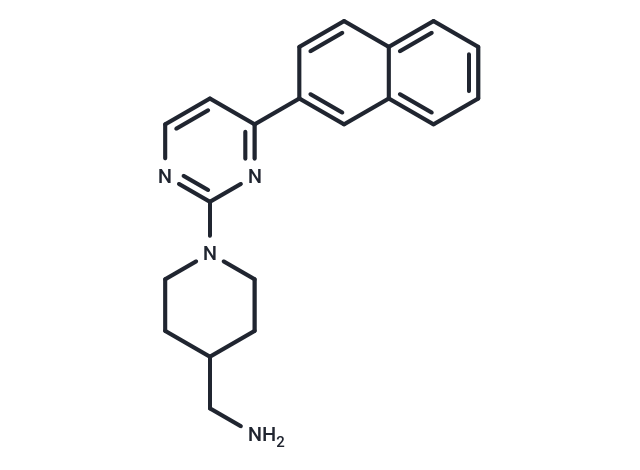Shopping Cart
Remove All Your shopping cart is currently empty
Your shopping cart is currently empty
WAY262611 is a Wnt/β-catenin agonist and an inhibitor of Dkk1. It increases bone formation rate with EC50 of 0.63 μM in TCF-luciferase assay.

| Pack Size | Price | USA Warehouse | Global Warehouse | Quantity |
|---|---|---|---|---|
| 5 mg | $58 | In Stock | In Stock | |
| 10 mg | $89 | In Stock | In Stock | |
| 25 mg | $175 | In Stock | In Stock | |
| 50 mg | $328 | In Stock | In Stock | |
| 100 mg | $493 | In Stock | In Stock | |
| 1 mL x 10 mM (in DMSO) | $64 | In Stock | In Stock |
| Description | WAY262611 is a Wnt/β-catenin agonist and an inhibitor of Dkk1. It increases bone formation rate with EC50 of 0.63 μM in TCF-luciferase assay. |
| Targets&IC50 | β-catenin (TCF-Luciferase assay):0.63 μM |
| In vitro | WAY-262611 demonstrates the highest potency, low kinase inhibition potential, and high solubility in the primary assay [1]. |
| In vivo | WAY-262611 exhibits exceptional pharmacokinetic properties and, upon oral administration, demonstrates a dose-dependent increase in trabecular bone formation in ovariectomized rats. Calvariae from wild-type mice treated with WAY-262611 display significantly increased bone formation rates (BFR), whereas knockout (KO) animals treated in the same manner show no difference from control, suggesting that WAY-262611 operates through the Wnt β-catenin pathway, likely via inhibition of Dkk-1[1]. |
| Kinase Assay | PI3K and mTOR kinase assay : Enzyme assays are done in fluorescent polarization (FP) format, adapted from the Echelon K-1100 PI3K FP assay kit protocol. Human class I PI3Ks and PI3K-α mutants (E545K and H1047R) are produced in Sf9 or purchased from Upstate Biotech. GST-GRP1 (murine) is produced in Escherichia coli and isolated by GST-Sepharose. Assay buffers are reaction buffer [20 mM HEPES (pH 7.1), 2 mM MgCl2, 0.05% CHAPS, and 0.01% β-mercaptoethanol] and stop/detection buffer [100 mM HEPES (pH 7.5), 4 mM EDTA, 0.05% CHAPS]. FP reaction is run for 30 minutes at room temperature in 20 μL of reaction buffer containing 20 μM phosphatidylinositol 4,5-bisphosphate (PIP2), 25 μM ATP, and <4% DMSO. FP reaction is stopped with 20 μL of stop/detection buffer (10 nM probe and 40 nM GST-GRP), and after 2 hours, data are collected using an Envision plate reader. The routine assays with purified FLAG-TOR (FL and 3.5) are performed in 96-well plates as follows. Enzymes are first diluted in kinase assay buffer (10 mM Hepes (pH 7.4), 50 mM NaCl, 50 mM β-glycerophosphate, 10 mM MnCl2, 0.5 mM DTT, 0.25 μM microcystin LR, and 100 μg/mL BSA). To each well, 12 μL of the diluted enzyme is mixed briefly with 0.5 μL test inhibitor or control vehicle dimethyl sulfoxide (DMSO). The kinase reaction is initiated by adding 12.5 μL kinase assay buffer containing ATP and His6-S6K to give a final reaction volume of 25 μL containing 800 ng/mL FLAG-TOR, 100 μM ATP, and 1.25 μM His6-S6K. The reaction plate is incubated for 2 hours (linear at 1–6 hours) at room temperature with gentle shaking and then terminated by adding 25 μL Stop buffer (20 mM Hepes (pH 7.4), 20 mM EDTA, and 20 mM EGTA). |
| Molecular Weight | 318.42 |
| Formula | C20H22N4 |
| Cas No. | 1123231-07-1 |
| Smiles | NCC1CCN(CC1)c1nccc(n1)-c1ccc2ccccc2c1 |
| Relative Density. | 1.169 g/cm3 (Predicted) |
| Storage | Powder: -20°C for 3 years | In solvent: -80°C for 1 year | Shipping with blue ice/Shipping at ambient temperature. | |||||||||||||||||||||||||||||||||||
| Solubility Information | DMSO: 42 mg/mL (131.9 mM), Sonication is recommended. | |||||||||||||||||||||||||||||||||||
| In Vivo Formulation | 10% DMSO+40% PEG300+5% Tween 80+45% Saline: 1 mg/mL (3.14 mM), Sonication is recommended. Please add the solvents sequentially, clarifying the solution as much as possible before adding the next one. Dissolve by heating and/or sonication if necessary. Working solution is recommended to be prepared and used immediately. The formulation provided above is for reference purposes only. In vivo formulations may vary and should be modified based on specific experimental conditions. | |||||||||||||||||||||||||||||||||||
Solution Preparation Table | ||||||||||||||||||||||||||||||||||||
DMSO
| ||||||||||||||||||||||||||||||||||||
| Size | Quantity | Unit Price | Amount | Operation |
|---|

Copyright © 2015-2025 TargetMol Chemicals Inc. All Rights Reserved.